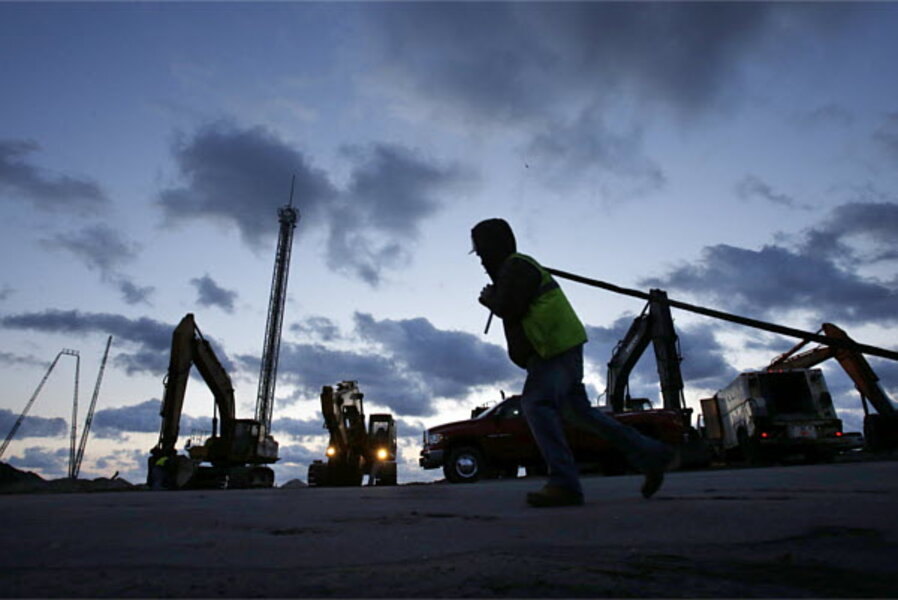One year after superstorm Sandy, homeowners ask, where's the aid?
Loading...
| New York
Nancy and Sal Zito, middle-class homeowners in Staten Island, are still bewildered where all this “rebuild New York” money they’ve heard so much about this year has gone.
One year ago, as they sat down with their two kids to eat some macaroni and play a household game of bingo, the surge from superstorm Sandy swept down Fairbanks Avenue and filled their basement with an oily flood – the family area, where their kids kept all their games and toys; an office area, where two computers sat; and the room with the washer, dryer, and furnace.
“The water just came down like a whoosh of force,” says Mrs. Zito, a stay-at-home mom. “Like a wave, like a tidal wave, just so quick.... It was salt water, sewage, seaweed, dead fishes: I can’t tell you how it smelled to high heaven.”
A year later, they’re still trying to recover – both emotionally and financially. And like many other Sandy victims throughout New York and New Jersey, they’ve almost given up on receiving any assistance to recover from the damage.
Not much of the $60 billion in total federal aid has reached homeowners like the Zitos – a full year after Sandy’s surge smashed through some 366,000 structures in these states. Specifically, barely a third of this aid package has been spent, according to officials.
Six weeks after the storm, the Zitos did receive a $7,000 grant from the Federal Emergency Management Agency (FEMA) to help replace their furnace. They had gone weeks without heat during chilly November nights. Overall, the federal agency disbursed more than $1.4 billion to individuals and homeowners in five states – mainly to help with the immediate costs after the storm.
But the much more difficult task of providing funds to rebuild has proved a gargantuan task. In New York, the Build It Back program, flush with $644 million, has made just a single grant – to a widow in Staten Island who lost her family and home to the storm. In New Jersey, the state has disbursed only $3 million out of $600 million in aid, part of the federal Community Development Block Grant Program administered by the New Jersey Department of Community Affairs.
Indeed, 75 percent of New Jersey residents who felt the impact of Sandy say they have been forgotten by the state’s rebuilding efforts, according to a survey by the Monmouth University Polling Institute released Monday.
The Zitos applied for a Build It Back grant this summer at a nearby school, where city workers were guiding applicants through the process. “I brought my mortgage, my FEMA papers, my tax returns, a letter from my insurance company showing they rejected me because we didn’t have flood insurance – and they said they would contact me in three weeks. But nothing, nothing at all,” Mrs. Zito says.
Since Mr. Zito is a maintenance worker with New York City’s Department of Transportation – he was working to take down signs in Brooklyn when the storm hit, in fact, removing objects that could become dangerous projectiles – there isn’t much money to spare.
One reason for the trickle of funds this year, officials suggest, was the rampant fraud after hurricane Katrina in 2005.
"We've done everything we possibly can, and I think in the immediate aftermath did a very good job," New Jersey Gov. Chris Christie (R) told the Associated Press this weekend. "Since then, we've kind of been hostage to two situations, the delay in the aid itself and then what I call the 'Katrina factor,' which is the much more detailed and difficult rules surrounding the distribution of the aid."
But officials are promising that things should soon change.
“The spigot is finally on, and the aid is now flowing,” said New York Sen. Charles Schumer (D) in a statement Monday. “Things moved too slow in the first year – there were bureaucratic hurdles to overcome and red tape to cut – but now the programs are up and running.”
Senator Schumer announced that New York would receive about $6.3 billion in aid next year, including $1.4 billion that will be sent directly to homeowners – and in a much more timely manner this time, he said.
“[This] is enough to rebuild almost every house, and create a community that is much stronger than before,” Schumer said. “We’ll continue to recover, and will be back stronger than before.”
After a year of having to scrounge up the money to gut their mold-ridden basement and replace their furnace and appliances, the Zitos hardly feel stronger now. They are racked with debt – about $25,000 on credit cards and a home equity loan. They had to rely on help from Mr. Zito’s friends, who got together to help rebuild their home after the costly demolding treatment ripped up the basement down to the concrete foundation.
And the experience of hearing all these numbers – billions and billions of dollars – has left them feeling left out and bitter after a year of struggle.
“We’re middle class, so it’s like we get nothing,” Mrs. Zito says. “We have to do it on our own; we can’t rely on the government. It’s a horrible thing to say, but it’s the truth.”








